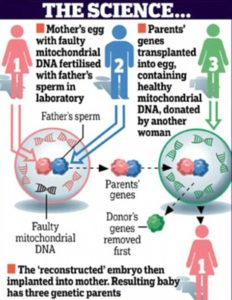Couple Entangled In Sperm Donor Battle
February 19, 2015Egg Donors Face IRS Taxation
March 24, 2015This month, the United Kingdom shattered the glass ceiling and became the first country to permit three people to have one child.
That may sound confusing at first, but here’s what is happening, and let me preface it by saying it is incredibly progressive.
It started with a vote in the House of Commons. They allowed a medical technique in where “donated” DNA from a “third party” is utilized to minimize the risk of genetic disorders that the parents may have, and in turn, pass on to their unborn child.
The proposal moved ahead with a vote of 382 in favor and 128 opposed and has been moved to the upper chamber of Parliament, the House of Lords. This medical methodology of DNA donation will be viewed as legal in the United Kingdom starting this October.
Rachel Feltman, a reporter for the Washington post wrote, “The babies that result from this technique can only attribute around .1% of their DNA to the third party, so ‘parent’ is a bit of a strong word. The donor provides only their mitochondria.” She added, “Often called the ‘power plants’ of the cell, the mitochondria converts energy from food into energy that can power a cell. When someone’s mitochondria don’t function properly, it’s bad news indeed.”
This technique is helping to eradicate some pretty horrific diseases. In the United States alone, it is estimated that up to 4,000 children are born with these mitochondrial life threatening illnesses.
This procedure was created by British medical researchers. Feltman said it takes mitochondria from a healthy female donor and then pools it together with the parents during IVF.
“This can be accomplished at either the egg stage or the embryo stage: In one method, two eggs are fertilized with the father’s sperm — one from the donor, and one from the mother — and the parents’ genetic information is inserted into the donor’s embryo, which has had everything but the mitochondria cleared out,” she wrote. Feltman continued, “In another, the nucleus of a mother’s egg cell is placed directly into a donor egg, replacing the original nucleus there.”
While there has been approval of three-parent babies, it’s had its share of disapproval. And this was echoed within the House of Lords.
Sarah Knapton from The Telegraph noted that although they approved the bill, some expressed worries that babies could be born sterile. In her article, she highlighted how opponents which include pro-life groups and particular church leaders gave their warnings that this bill was brought forth in haste.
They also cast additional doubt saying it teetered on a “slippery slope” argument leaning toward designer babies.
Knapton wrote, “Lord Deben called for a delay and asked peers to form a committee to look at the safety and legality of the procedure. He warned that children born from the technique could be sterile and argued that the majority of the public did not agree with the procedure,” he said.
Lord Deben told his peers, “We have to protect three sets of people, the families, the children and the wider society. We should be concerned about the children who would be born in these circumstances. There are real doubts about safety.”
Despite protests from Lord Deben and Former Attorney General Baroness Scotland, the other side retaliated in their verbal war.
Lord Howe told the House of Lords that mitochondrial replacement could give real hope to families.
He went on to say, “It would be cruel and perverse to deny them that opportunity for any longer than necessary.”
Lord Winston sided with Lord Howe. Lord Winston is also recognized at Great Britain’s leading fertility experts.
He told the Lords, “I don’t believe that this technology threatens the fabric of our society in the slightest bit. On the contrary in a way it protects it. What we’re doing is recognizing our limits by accepting regulation.”
Third-party DNA can help eradicate mitochondrial life threatening illnesses. There is no question in my mind that the United Kingdom has done something extraordinary.




